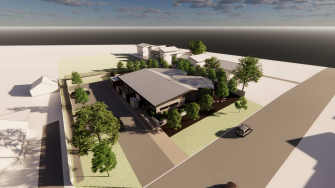Much needed Queanbeyan respite centre can save health system millions
A new respite centre in Queanbeyan can save the government millions of dollars in health costs and deliver much needed care for locals, a UNSW Canberra evaluation has found.
A new respite centre in Queanbeyan can save the government millions of dollars in health costs and deliver much needed care for locals, a UNSW Canberra evaluation has found.

Researchers at UNSW Canberra have found that a dedicated respite centre for the Queanbeyan community could save the health system millions of dollars.
Yvonne Cuschieri House, which is being built by local charity group Respite Care for QBN, will cater to carers and their loved ones aged 18 to 60, an age group with few suitable respite options.
UNSW Canberra has conducted an evaluation of the need for the service and the likely impact it will have for carers in the region. The report found that the facility, which has secured government funding to be built, warrants an ongoing commitment from state and federal governments to cover operational costs.
UNSW Canberra Associate Professor James Connor said respite is an essential service to reduce burnout, psychological distress and social isolation for carers.
“Unfortunately, 89 per cent of carers have never used respite services; primarily because there are so few suitable places they can take their loved one for respite,” Associate Professor Connor said.
“Consequently, carers soldier on without any break from their 24/7 caring duties, which places a huge burden on their mental and physical health.”
Research shows that non-clinical respite can relieve about 50 per cent of the overall cost burden from public hospital admissions of carers and can cost as little as 10 per cent of the cost of an Emergency Department visit.
Informal care in Australia in 2020 was worth $77.9 billion and in NSW, to replace the care provided, the NSW Government would have to spend more than $25 billion each year.
“Carers are at greater risk of poor health than the general population,” Associate Professor Connor said.
“They’re twice as likely to be socially isolated, and 50 per cent of carers suffer from high psychological distress. There is an overwhelming need for age-appropriate, non-clinical respite care.
“The new facility in Queanbeyan will not only save the public health system money, beds and precious resources, but it will provide countless intangible benefits, quality of life and dignity for those navigating chronic and life-limiting illness.”
The new six-bedroom respite facility will provide professional, non-clinical, short-term accommodation for people in the chronic or recovery phase of illness and who require low to medium care in the Queanbeyan-Palerang region.
Respite Care for QBN chair, Paul Walshe OAM, said Queanbeyan is home to about 4,500 unpaid carers who would hugely benefit from the new centre.
“We have received thousands of signatures petitioning for this service, so to finally be close to opening this much-needed centre is an incredible feeling,” Mr Walshe said.
“It’s been a long time coming to get the centre to this point. The next big step for us is to secure ongoing government funding for staff and other operational costs, to ensure that the centre can become fully embedded in the Queanbeyan community for decades to come.”
The driving force behind the respite centre for many years was Queanbeyan local Yvonne Cuschieri OAM.
“When Yvonne’s son Steven was left paralysed following a brain tumour and required constant care, the only option was to move him into a nursing home,” Mr Walshe said.
“This never sat well with Yvonne.
“It inspired her to support others by building a new, non-clinical respite facility in Queanbeyan that is suitable for 18 to 60-year-olds, for whom aged care respite is often the only option.
“The new centre will give those families another option and, as the research tells us is important, will be home-like and provide them a private space where they can feel safe, dignified and engage with family and friends in a home away from home.
“Unfortunately, Yvonne will not see her dream come true as she passed away on 18 June 2021, after her own long and courageous battle with cancer.”
Yvonne Cuschieri House is expected to be operational in mid-2024.